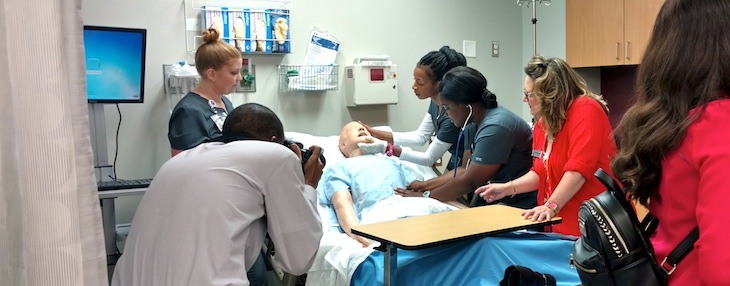CHI St. Vincent, UALR announce local initiative to address state’s nursing shortage
by May 18, 2017 1:25 pm 1,126 views

In an effort to address the state’s growing nursing shortage, CHI St. Vincent and the University of Arkansas at Little Rock on Thursday (May 18) announced a three-year initiative to expand the ranks of nursing students, faculty and professionals.
During a brief ceremony at UALR’s Pat Walker School of Nursing, CHI St. Vincent and university officials signed a memorandum of understanding that will expand student capacity through the nursing school’s Pathway Program and fill nursing staffing vacancies at the local hospital group.
Under the agreement, UALR will recruit and educate 40 students yearly through the 18-month accelerated program to obtain an associate of applied science degree. Those same students will then be able to obtain their Registered Nurse (RN) license and begin work at CHI St. Vincent.
“Health care providers across the country are looking for ways to tackle this critical nursing shortage, and we see this investment in education as an important step toward preparing motivated students for an honorable and worthwhile profession in nursing,” said CHI St. Vincent CEO Chad Aduddell.
UALR Chancellor Andrew Rogerson said the collaboration with CHI St. Vincent is an excellent example of the symbiotic role between a metropolitan university and its community. CHI St. Vincent, part of the national nonprofit hospital giant Catholic Health Initiatives, has hospitals in Little Rock, Sherwood, Morrilton and Hot Springs that are supported by a network of primary and specialty care clinics.
“Our pledge to central Arkansas and the entire state is to help address and solve the challenges our businesses and organizations face through educational opportunities,” he said. “UALR has collaborated with CHI St. Vincent for more than 50 years to educate nurses in central Arkansas. This newest initiative is yet another strategy to give more Arkansas students a pathway to a quality health education and to create a pipeline to a career beginning at a world-class health system.”
After the ceremony, Aduddell said CHI St. Vincent will invest $333,000 per year in the local initiative, which will provide financial support to hire additional faculty and staff through the hospital’s philanthropic foundation to create greater capacity for UALR to admit more students.
The first step for the new program will be to increase nursing student enrollment at UALR by hiring additional faculty. Once that takes place, students in the Pathway Program seeking a nursing degree will be awarded $2,500 per semester to cover the tuition cost for the accelerated classwork.
“The current shortage of nursing and faculty is projected to increase, and we are working to change this situation today,” Aduddell said.
NURSING SHORTAGE ‘SCARY’
Leah Smith, a registered nurse at St. Vincent, spoke in detail about the need for more nurses at local hospital. Often, Smith said, nurses are put in dangerous situations because they are overworked and have to take on a myriad of additional responsibilities.
“It’s scary,” said Smith, who graduated from the UALR nursing program two years ago. “We really need nurses that are caring and compassionate and have a heart for people.”
According to UALR officials, the first 40 students who participate in the university’s Pathway program this fall will join the nursing staff at CHI St. Vincent for a minimum of 24 months upon graduation.
“This agreement is like the trifecta,” Rogerson said. “First and foremost, it’s a win for Arkansas in need of quality patient care. It is also a win for increasing student capacity at UALR and patient capacity at CHI St. Vincent, plus a win for student seeking a rewarding career in a high-demand field.”
According to the U.S. Bureau of Labor Statistics, healthcare occupations and industries are expected to have the fastest employment growth and add the most jobs between 2014 and 2024 as a much of the nation’s labor force enters retirement age.
The healthcare and social assistance sector is expected to become the largest employing sector during the decade, overtaking the state and local government sector and the professional and business services sector. Healthcare and social assistance is projected to increase employment share from 12% in 2014 to 13.6% in 2024. Employment of registered nurses is projected to grow 16% during the same period, much faster than the national average for all occupations.
NURSING SHORTAGE EXPECTED TO WORSEN
The U.S. is projected to experience a shortage of RNs that is expected to intensify as Baby Boomers age and the need for health care grows. Labor Department officials forecast that 1.2 million vacancies will emerge for RNs between now and 2022, the largest nursing shortage since the introduction of Medicare and Medicaid in the 1960s.
“Compounding the problem is the fact that nursing schools across the country are struggling to expand capacity to meet the rising demand for care given the national move toward healthcare reform,” says the American Association of Colleges of Nursing (AACN).
On a positive note, the Department of Labor’s job outlook for registered nurses shows that hiring prospects are expected to be good for years to come. A 2016 report noted that the supply of new nurses entering the labor market has increased in recent years, resulting in increased competition for jobs in some areas of the country.
As of May 2016, BLS data shows there are nearly 3 million nurse practitioners in the healthcare field making an annual wage of more than $72,000. In Arkansas, there are an average of about 19 RNs in Arkansas for every 1,000 jobs, or some 23,380 nurses statewide. Those same registered nurses make an average of more than $57,000 annually, which is well below all surrounding states except for Mississippi.
